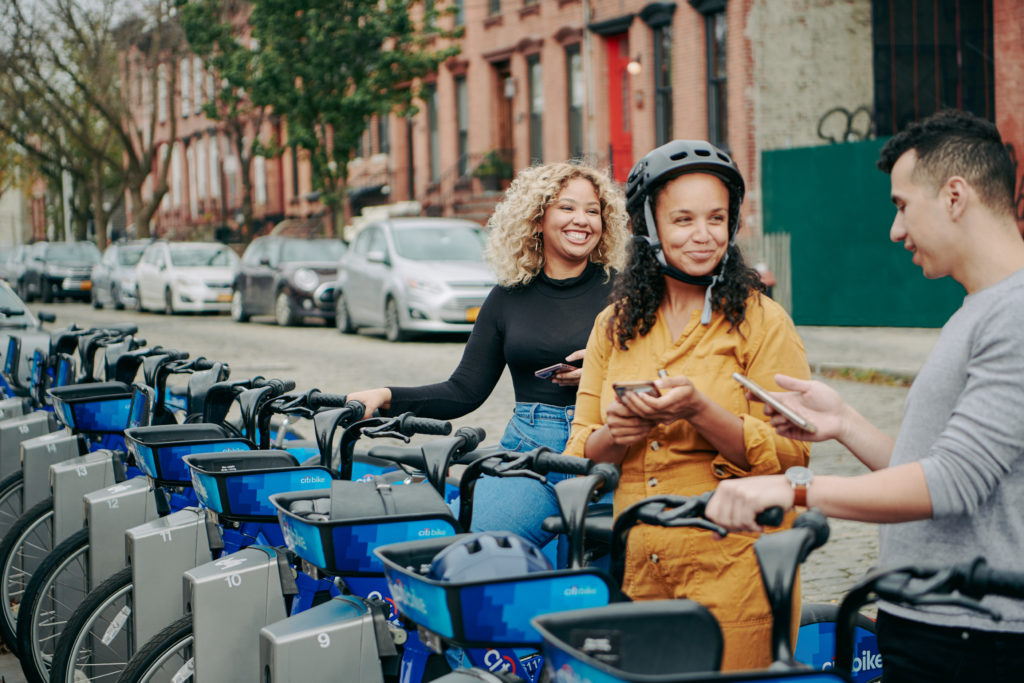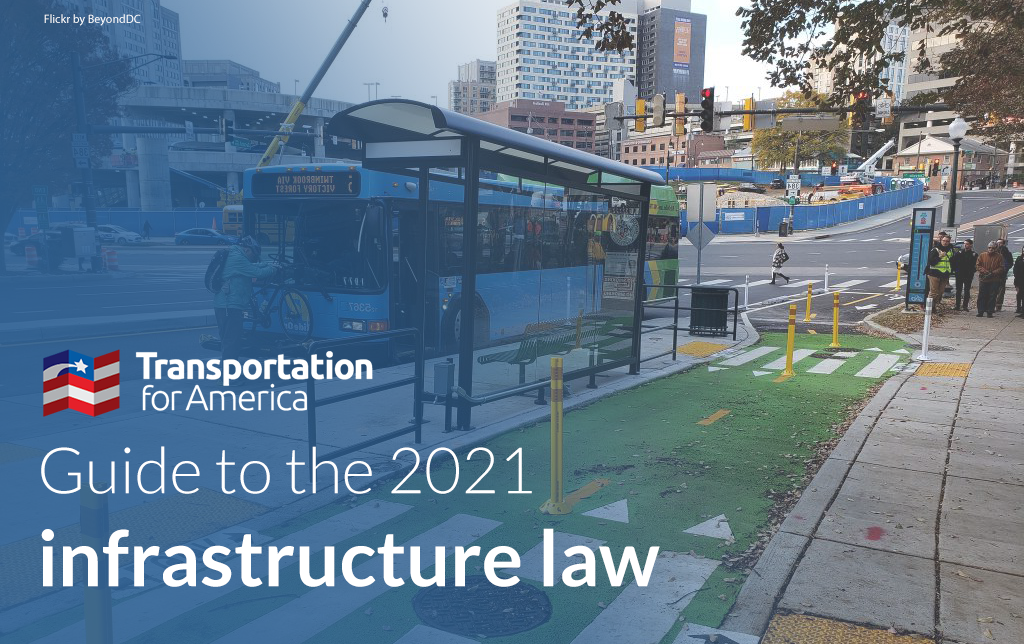What does the new infrastructure law mean for micromobility?
What does the new infrastructure law mean for micromobility?
The expansion of grant and formula eligibility in the infrastructure law to include micromobility will give communities and states additional options for providing more transportation options, but those that are doing the most to make their streets safe and convenient stand to gain the most as well.


This post is one part of what T4America is producing to explain the new $1.2 trillion Infrastructure Investment and Jobs Act (IIJA), which now governs all federal transportation policy and funding through 2026. What do you need to know about the new infrastructure law? We know that federal transportation policy can be intimidating and confusing. Our hub for the new law will walk you through it, from the basics all the way to more complex details.
Micromobility—local travel on smaller vehicles like bikes, scooters, or other personal mobility devices—has become a vital part of our mobility landscape in just a few short years. The recent growth of shared micromobility networks owned and maintained by either cities or private companies has made such vehicles accessible and popular in urbanized areas. For example, Citi Bike in New York City grew 38 percent year-over-year, with a total of 28 million rides taken in 2021; based on ride volume, Citi Bike would be ranked as the 25th largest transit system in the US.
When these networks are integrated into public transit systems, like in Los Angeles, they act as extensions to trains and buses that allow passengers to make valuable first- and last-mile connections. During major disruptions in transit service, such as in New York or Washington D.C., they can act as vital reinforcements.
The most notable change in the infrastructure law on this count was to expand the eligibility of numerous programs to include micromobility. Below, T4America breaks down those policy changes, funding opportunities, and how best to advance micromobility in your community.
What’s in the law?
The 2021 infrastructure law is the first to authorize shared micromobility infrastructure—which can include vehicles, docking stations, protected lanes for bikes and scooters, or apps and websites for public access to shared networks—and operations funding. The most notable change comes from expanding the eligibility within the existing Transportation Alternatives Program, which “sets aside” 10 percent of each state’s Surface Transportation Block Grant Program—a state’s second biggest pot of federal funds—for transportation alternatives. Since 2015 this program has included projects to make walking or biking safer and more convenient; now, shared micromobility is an eligible project type.
This is a small but notable step to recognize the dramatic changes in our mobility landscape over the last decade, but whether or not any of this funding encourages greater shared micromobility will be left up to the states and metro areas who decide how to spend these funds.
Micromobility projects can also be advanced by new and revised infrastructure programs dedicated to climate change mitigation, transit improvements, safety, and disaster resilience. Other highlights include the new Carbon Reduction Program and the Active Transportation Infrastructure Investment Program, which funds projects under $15 million that focus on safety, are designed to increase pedestrian and cyclist activity, and build active transportation networks. Also notable is the new Safe Streets and Roads for All program, which is intended for initiatives that reduce traffic fatalities, including “complete streets” projects that foster active transportation use.
The formula-based programs below are perhaps the best opportunities for states, MPOs and local governments to leverage funding for micromobility. These programs are not competitive, so it is up to these governments to use this money effectively as outlined.
| Formula Program Name |
Authorized funding | Can be used for: | Should be used to: |
|---|---|---|---|
| Transportation Alternatives Program (TAP) | $7.2 billion over five years. (10% of each state’s Surface Transportation Block Grant program funds) | Recreational trails, bike/ped projects, micromobility, and other types of transportation alternatives. | Expand useful micromobility options and build connective networks in communities that address demand. |
| Congestion Mitigation and Air Quality (CMAQ) Improvement Program | $2.745 billion | Transportation projects or programs that reduce congestion and improve air quality. CMAQ funding can be used for both capital and operating expenses. | Maximize MPO provisions for bike- and scooter-share capital projects and operations. Use funding to support operations that increase equity and program reach. |
| Carbon Reduction Program | $6.4 billion | Planning, designing, and building on- and off-road active transportation facilities; roadway right-of-way improvements. | Fund complete street designs that integrate micromobility infrastructure such as protected lanes and docking stations. |
| National Electric Vehicle Infrastructure (NEVI) Formula Program | $5 billion | Implement electric vehicle charging on designated Alternative Fuel Corridors, with remaining funds being spent at discretion of state governments. | Implement electric bike/scooter charging facilities as part of integrated micromobility networks. |
| Promoting Resilient Operations for Transformative, Efficient, and Cost-saving Transportation (PROTECT) | $7.3 billion (formula) $1.4 billion (competitive grant) |
Extreme weather resilience and emergency response infrastructure. | Implement micromobility vehicles and stations as a redundancy measure for evacuation or recovery mobility processes. |
| Urbanized Area Formula Grant Program | $33.5 billion | Planning, operation, and capital improvement for public transportation systems. | Build micromobility infrastructure at and nearby public transportation facilities and promote integration of bike- and scooter-share systems with local transit fares and services. |
The following programs are competitively funded (discretionary), and winning these grants is tied to strong local matching (at 20–50% of the project cost).
| Competitive program name | Authorized funding | Can be used for: | Should be used to: |
|---|---|---|---|
| Active Transportation Infrastructure Investment Program | $200 million, subject to annual appropriations and the whims of Congress | “Active transportation” projects. | Finance micromobility stations and vehicles as part of useful active transportation networks. |
| Safe Streets and Roads for All | $6 billion | “Vision Zero” plans and implementation projects. | Incorporate micromobility stations and protected lanes into complete streets projects. |
| Rural Surface Transportation Program | At least $25 million to each eligible project | Most projects on rural roads, including projects that protect all road users but also highway projects with adverse effects. | Introduce micromobility infrastructure to streets in rural areas; prioritize electric micromobility funding to achieve longer-distance trips. This should be framed so rural areas do not only have one choice in spending these funds. |
| Local and Regional Infrastructure Project Assistance (a.k.a RAISE) | $15 billion (not a new program, but this funding is substantially more than in the past) | Local or regional projects that improve safety, environmental sustainability, quality of life, economic competitiveness, state of good repair, and community connectivity. | Prioritize shared micromobility infrastructure that benefits surrounding communities, improves bike/pedestrian safety, and serves communities equitably. |
How else could the administration improve micromobility?
To further aid the development and expansion of shared micromobility infrastructure, there are several steps the administration could take.
Further study and guidance is needed on how micromobility can be integrated with transit to better support ridership and access. Micromobility options work best when they circulate short distance trips within communities and connect them to transit facilities for longer-distance travel. In Washington, D.C., for example, 82 percent of Capital Bikeshare riders have used shared micromobility services to get to or from public transit. Best practices in design, both national and international, should inform more pointed recommendations and project eligibility standards for shared vehicle infrastructure.
The administration needs to provide guidance and technical support so everyone can fully understand how their projects can be made eligible for each grant. Many agencies won’t know much about micromobility eligibility, and USDOT can and should help fill those knowledge gaps.
In light of these suggestions, it is important for local and state governments to also consider every point of flexibility within the infrastructure law to fund micromobility infrastructure. For example, funding for electric vehicle infrastructure can be used to support electric scooter and bicycle charging facilities. The administration should also evaluate grantees based on how they will protect and connect disadvantaged users and communities. Colorado is establishing an emissions budget for new highway projects that requires corresponding investment in greener modes, which could be a good model for a cross-program policy.
How can the new money advance our goals?
Safety
The most significant constraint on the expansion of shared micromobility is the supportive infrastructure that makes riding on a bike or scooter feel safe, in both perception and reality. This can include fully protected bike lanes, visible and enforced curbside pickup/dropoff zones, complete signage and wayfinding standards for bicycles and other shared mobility options, and traffic control improvements such as signal retimings that allow micromobility users to safely traverse streets. Places that will realize the greatest benefits of expanded shared mobility options are those that also make safety the fundamental consideration of every other dollar spent.
Climate
Micromobility is a valuable tool in helping to decrease driving (and emissions) for short-distance trips, which are the bulk of all trips taken each day. Good micromobility service can also increase transit ridership by improving access and expanding the catchment area around stations, helping to lower emissions with greater transit use at the same time. Moreover, a 2021 report by Lyft states that 41 percent of its micromobility customers are weekly users of public transit and 54 percent do not own or lease a personal vehicle. The design of micromobility access points and networks is also important. Incorporating shade into station and protected lane designs can go a long way toward reducing the disastrous urban heat island effect, which can come from trees or in the form of solar panels.
Equity
When administered and implemented thoughtfully, micromobility makes car-free transportation accessible in areas that are underserved by our current road network. Localities will need to plan the location, price, and other features of bike- and scooter-share in a way that is viable across all communities. In particular, micromobility must address the fact that Black, Hispanic, and Native American pedestrians are disproportionately killed on America’s roads, and safety improvements should be prioritized where they are most needed. Furthermore, low-income communities experience the brunt of the urban heat island effect. When planned equitably, incorporating shade and landscaping into micromobility stations can be a step toward making such communities more resilient to high temperatures.
So what?
States, regions, and communities now have several avenues through which federal funding for micromobility is available. But micromobility is one of many applications from an already small funding pool, and without a thoughtful overarching plan for implementation, new initiatives will have limited and inequitable benefits. As such, advocates must work with their governments to pursue a detailed, equitable vision for micromobility so they can build a strong case for federal funding and the local matches needed to secure it.
Note: There are ample opportunities for the infrastructure law to support good projects and better outcomes. We have also produced short memos explaining the available federal programs for funding various types of projects. Read our memo about available funding opportunities for micromobility projects.
Source: What does the new infrastructure law mean for micromobility?